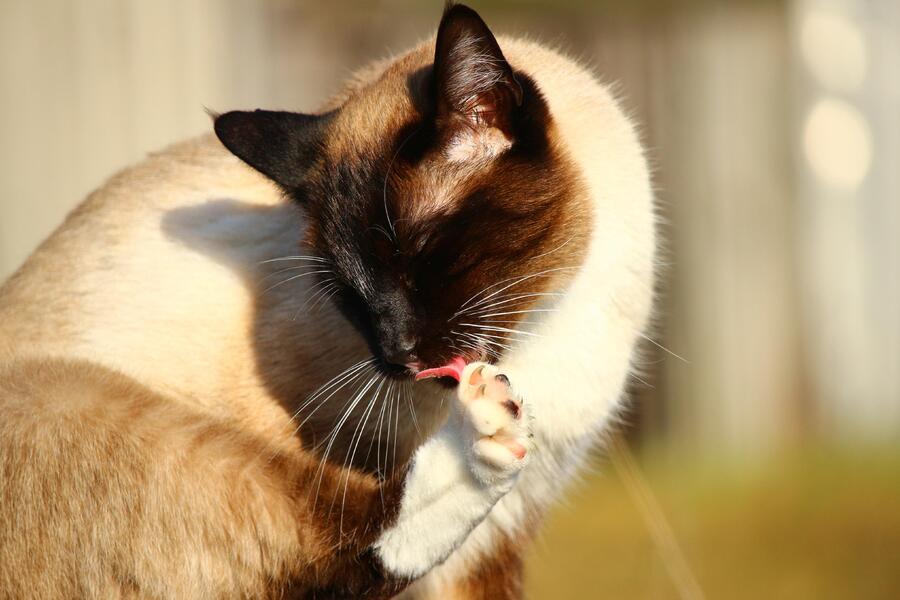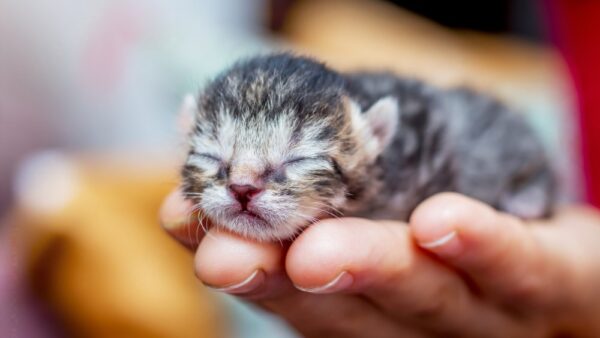Hair loss in cats can be caused by allergies or skin infections, or in severe cases, by a metabolic disorder.
Chronic stress or excessive licking of an area can also cause hair loss in one particular spot. Stop the cat from licking and chewing on the area with a t-shirt or collar (cone).
Examine the area for redness, parasites, bleeding, bruising or discharge. If you see targets or a red “ring” of irritation, it may indicate a fungal infection called ringworm.
What Causes Cats To Lose Fur Around Their Necks?

A clump of fur at the neck of your cat can be a sign of a more serious issue. If you’ve noticed your cat losing fur around its neck, you may be wondering if there’s something wrong with its diet.
While cats require the proper balance of protein and nutrients to grow fur, a poor quality coat may also be an indication of something else.
You should discuss your cat’s diet with your veterinarian and give it a month or two before instituting a drastic change in its diet.
Food allergies in cats may also cause hair loss around the neck. Food allergies cause itchiness and oozing sores. In addition, affected cats often develop chronic ear infections and lose hair quickly.
In order to diagnose a food allergy, your veterinarian may run a series of food trials to determine if your cat is suffering from a specific type of food.
Afterward, he or she will gradually reintroduce the food one at a time. Psychogenic alopecia – In some cats, hair loss is caused by a hormonal imbalance.
In such cases, the veterinarian may prescribe a medication to control the symptoms.
Other causes of a cat losing fur around the neck include inflammation and bacterial infections. Aside from infections, cats can lose fur around the neck because of inflammation or metabolic stress.
Other underlying diseases, like diabetes, can also cause alopecia. Other rare conditions include immune-mediated diseases, metabolic stress, and overgrooming.
However, you should always see your veterinarian if the hair loss is chronic.
Treatment For Missing Neck Fur In Cats
If you have noticed your cat’s neck fur is missing or thinning, you should visit your veterinarian. A punch biopsy can be performed on the same day as your initial visit and can give you results within 48 hours.
A pathologist specializes in reading skin tissue, and your veterinarian may need to use a special lab to perform this test.
Your veterinarian will inject local anesthetic in the affected area of skin. Then, using a tiny cookie cutter-like instrument, he or she will scrape small plugs of skin away. Your cat will probably have stitches in each area.
Best Supplement For Cat Hair Loss
There are many causes of cat hair loss, including poor diet, allergies, and food intolerances. Stress, however, is the most common culprit.
Since cats are unable to communicate, they cannot express their feelings through hair loss. Stress-related factors include changes in routine, new people, and constant noise.
Thankfully, there are a number of different solutions to this problem. These solutions will help you keep your feline friend’s coat and hair healthy.
One of the best supplements for your cat may contain biotin, a nutrient that supports skin, nerve, and digestive health.
Biotin has been found to be beneficial for a wide range of problems, including hair loss and cradle cap. It may also help to improve the health of your cat’s follicles and fight depression.
Another solution for cat hair loss is a supplement called Shed-X, which is a powdered formula that contains essential amino acids and vitamins.
Another option for cats is Blue Buffalo dry cat food. This food is suitable for outdoor cats, as it contains a blend of natural ingredients and high-quality protein.
The dry formula is easy to digest and contains no artificial ingredients. However, it can contain some ingredients that might upset your cat’s stomach.
Regardless of which supplement you choose, it’s a good idea to choose a food that contains a high amount of chicken in it, as chicken is a high-protein source for cats.
Another cause of cat hair loss is food allergies. Cats require adequate protein, vitamins, and fatty acids to maintain a healthy coat and skin.
A cat’s hair will be thin and brittle if it doesn’t have adequate levels of these nutrients. To identify the cause of your cat’s hair loss, you should start feeding your feline friend a hypoallergenic diet.
Cats that suffer from this condition may also experience other symptoms, including changes in appetite, weight loss, and fever.
Common Skin Problems In Cats
Your cat might be experiencing one or more of these common skin problems. Symptoms vary, depending on the underlying cause.
If your cat is missing neck fur, he or she may have an underlying skin condition. Fortunately, a veterinarian can diagnose your cat’s skin problem and recommend the most effective treatment.
Listed below are some of the most common skin conditions in cats. Read on to learn about the most common causes of these conditions and their treatments.
Allergic reactions can cause miliary dermatitis or scabby cat disease.
Allergic reactions trigger an inflammatory reaction in your cat’s skin. Your cat may scratch, lick, or bite at the affected area, and eventually develop painful lesions covered in scabs.
Symptoms of miliary dermatitis can appear anywhere on a cat’s body, including the neck.
A cat with missing neck fur may also be prone to a fungal infection. This skin infection is highly contagious and can occur anywhere on the body.
Most commonly, it affects the face, thighs, and pads of feet. It can also be caused by allergies to certain foods or fleas.
Treatment for ringworm depends on the type of disease your cat is suffering from, but it’s worth noting that this condition is treatable.
Lack of neck fur can lead to several other common skin problems in cats. Feline miliary dermatitis is the most common cause, but the disease may be caused by other types of allergens.
Allergic reactions can cause rashes, scabs, and bald patches. If you notice the affected area, consult your veterinarian as soon as possible.
Sores are a common sign of miliary dermatitis in cats, but they can also be a symptom of an underlying condition.







Leave a comment